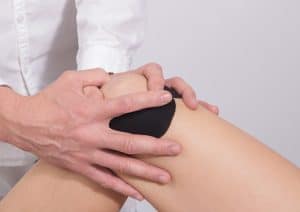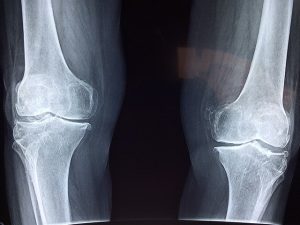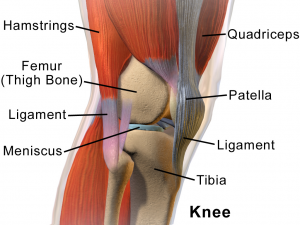
New York Knee Injury Attorneys
No matter how big or small the car is that you are traveling in, there is always a chance that a sudden collision may leave you with a serious knee injury. This same type of harm can also occur after a fall from a great height – or while walking across slippery or uneven street and sidewalk surfaces. These are the common causes of knee injuries: auto accidents, motorcycle crashes, pedestrian knockdowns, bicycle accidents, athletic activities, trip and falls, premise liability, construction accidents, and many others.
When this type of personal injury can lead to serious problems, you should be seen right away by an emergency room doctor, preferably an orthopedist. It is always best to get checked out instead of trying home care. In addition to knees ramming into vehicle dashboards during head-on collisions (especially when seatbelts are unfastened), other knee injuries can occur when the knee’s ligaments and bones are stretched or otherwise damaged.
Although some knee (patella) damage can take weeks or months to become noticeable, you must always obtain immediate diagnostic care and treatment when swelling and pain are present. The information below reviews basic facts about the structure of the knee (or patella), how common knee injuries occur, frequent symptoms and preferred approaches to treatment.
Basic facts about the structure of the knee
- Due to the many bones, cartilage, and ligaments that support it, the knee is the largest joint located in the human body.
- The patella or knee bone is composed of tendons, cartilage, bones, and ligaments.
- The three bones that join each other to form the knee are the tibia (shinbone), the femur (the thighbone), and the patella (kneecap).
- Articular cartilage is the slippery substance that covers the tips or ends of the tibia and femur, as well as the back of the patella. This material helps all the knee bones move smoothly against each other as you walk, jump, or otherwise move about on your legs.
- The ligaments are the parts of the body that connect our bones to other bones. They operate in that same manner within the knee joint.
- The meniscus. We each have one of these “wedge-shaped” pieces of cartilage in each knee to provide us with “shock absorption” as we walk around, jog, play basketball or otherwise place heavy burdens on our knees.
A few other key parts of the knee are mentioned below. As the list indicates, people often incur many other ailments in addition to “dashboard knee.”
Most common knee injuries – often caused by motor vehicle accidents and falls
- Damage to the posterior cruciate ligament (PCL). When your kneecap sustains a blow to the front of it while bent, the PCL often tears. This frequently happens during car or truck accident — or due to bad falls.
- Collateral ligament damage. Within the large knee joint, numerous ligaments provide the knee with its ability to sustain lesser blows or twisting injuries.
- Tears in the menisci. In many cases, the damage is only suffered in one meniscus — the part of each knee that acts as a shock absorber. A torn meniscus is the most common injury leading to arthroscopic knee surgery and can lead to pain and decreased range of motion.
- Anterior cruciate ligament (ACL) injuries. While most of these happen after someone jumps up and lands incorrectly, it can also happen due to a fall (or motor vehicle accident). Patients often report a “popping” sound when their ACL is injured.
- Medial Collateral Ligament (MCL) or posterior collateral ligament (PCL) injuries are torn ligament injuries to the knee involving different ligaments. These are serious injuries that could require a total knee replacement.
- Articular cartilage – chondral defect. This surface part of the knee can be damaged, even though the rest of the joint remains healthy.
- Articular cartilage – osteoarthritis. Although this type of injury process can take years to form, people who have either been in numerous car accidents or played highly competitive sports (like tennis, basketball or hockey) often report this type of problem as they grow much older.
- A knee fracture to the tibial plateau can be a devastating injury requiring medical attention, and surgery.
Frequent symptoms that patients report after suffering bad knee injuries
- Shooting or stinging pains that will not quickly go away. You must work carefully with your doctor. to select a painkiller that will not cause drowsiness. Otherwise, you may increase your chances of falling or otherwise injuring yourself again.
- A complete inability to move the knee and knee pain. Some patients will describe this as feeling as though their knee has “locked up.” Movement in any direction appears to be impossible because unbearable pain occurs. The knee pain can turn into chronic pain.
- Limping is necessary whenever you try to walk. When this occurs, a treating doctor will often suggest you use a leg brace, crutches – or both. When severe pain prohibits walking, doctors may prescribe medical supplies such as a walker.

When filing a personal injury lawsuit and working with accident lawyers to build the strongest legal action focus on the client relationship is very important. Experienced trial lawyers can ensure the maximum settlement or jury verdict on your behalf.
What is the common treatment for knee injuries?
Surgical and nonsurgical approaches to treatment
- Surgical. Your doctor will often suggest that something like an ACL tear should be handled arthroscopically — using miniature instruments. This approach is often highly desirable because it can sometimes cut down on how long it will take you to heal after post-surgery physical therapy and rehabilitation. However, there are also major knee injuries that require open surgery. This provides the doctors with both easier access to the damaged parts of the knee and a direct view of them. Types of knee surgery include:
-arthroscopic knee surgery or more involved surgery such as an ACL reconstruct
-knee replacement surgery - Nonsurgical approaches to treatment. Your treating physician may choose to simply immobilize the knee area by having you wear a brace or cast. Most soft tissue injuries can be resolved with conservative treatment such as physical therapy. This can hold the bones in proper alignment during the healing stages. You may also be required to use crutches so your knee area will not have to bear too much potentially damaging weight.
Physical therapy. Highly specific exercises designed for your unique injuries can help strengthen your leg muscles as the entire knee area heals.
Medications are also used, sometimes in combination with one of the other treatments already referenced above. These anti-inflammatory and nonsteroidal drugs, which may include ibuprofen and aspirin, can greatly diminish the swelling and pain that must be endured.
Why do I need a personal injury lawyer with experience handling knee injury claims?

If an insurance company refuses to offer a reasonable settlement to a personal injury attorney, that attorney must have the litigation experience and knowledge of the client’s particular injury to prepare for and take the case to a jury trial in New York State. Otherwise, the client’s personal injury case can be delayed, dismissed, or forced into a low settlement.
What recovery or damages can I obtain after a NYC knee injury?
The types of recovery after a knee injury include:
- compensation for pain and suffering, loss of enjoyment of life
- reimbursement for medical bills as well as future medical expenses and medical benefits such as surgery, prescriptions, physical therapy, orthopedic visits, and other medical treatment you will need in the future
- lost wages, lost salary, and other economic losses
How much can I recover from my knee injury?

Ultimately the amount of recovery in damages will depend on how serious the knee injury sustained. For example, an injury with tendon tears, blood clots, and lost income requiring a knee brace that is a debilitating injury and requires a knee replacement procedure will be a compensation claim worth over $1 million while an injury that does not result in any permanent disability, joint damage, or knee trauma will result in a knee injury settlement worth considerably less. Any permanent impairment such as damage to knee cartilage, torn ligaments, a torn meniscus, knee fracture or broken lower leg bone where a surgical procedure is needed followed by long term rehabilitation will be worth a substantial amount. An injury that resolves after a few visits to a physical therapist can also have value but significantly less.
What are some examples of knee injury claims your firm has received?
Our firm has received the following personal injury settlements and verdicts on behalf of clients who filed insurance claims after suffering common types of knee injuries:
- $575,000 for an accident victim who needed arthroscopic knee surgery after physical therapy medical care and had a decreased range of motion. This case was filed in Supreme Court Kings County (Brooklyn).
- $1,250,000 for knee damage requiring open reduction internal fixation (ORIF) surgery and other medical treatment for broken bones. This knee injury lawsuit was handled in the Supreme Court of the State of New York Queens County.
- $400,000 settlement for an accident victim who had a torn anterior cruciate ligament (ACL) with surgery among other medical care. This is a torn ligament in the knee. This case was filed in Supreme Court New York County (Manhattan). Our client was a construction worker who tripped over debris sustaining this serious injury.
- $500,000 settlement for knee surgery. This auto accident lawsuit was filed in Supreme Court Bronx County.
- $200,000 for a vehicle collision in Staten Island with a knee surgery against a third party defendant driver who rear-ended our client’s car due to distracted driving.
- and many other six and seven-figure results. Our legal team is always available for a free case evaluation. If we accept your injury lawsuit for legal representation there is never a fee unless we win money for you first. Our goal is to help injury victims and families recover full compensation after a related knee injury. Contact us to find out if you have a strong case.
If you have suffered a severe knee injury after an accident caused by someone else’s negligence, please contact our New York City knee injury attorneys for a free consultation about your injury claim.
Our law firm will carefully investigate all the facts of your case, review all your medical records, and then fight hard to win the maximum compensation available for you. Your accident attorney will fight to ensure that every client fully recovers for all lost wages, pain and suffering, medical expenses, and other losses.
Fill out the form below & we will contact you as soon as possible.
We can tell you if you have a case or not within five minutes, Call (866) 288-9529
FREE CONSULTATION · NO FEE PROMISE · OVER $900 MILLION RECOVERED



